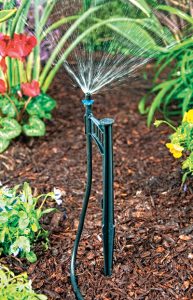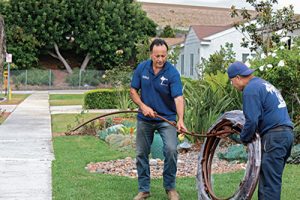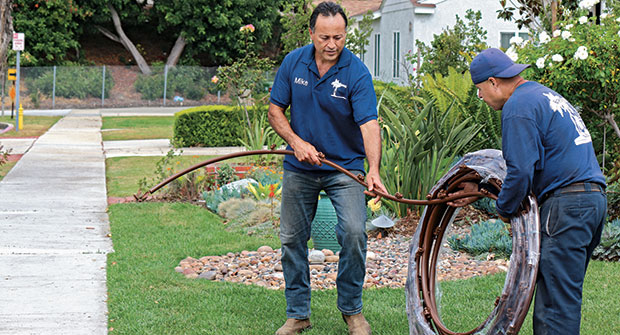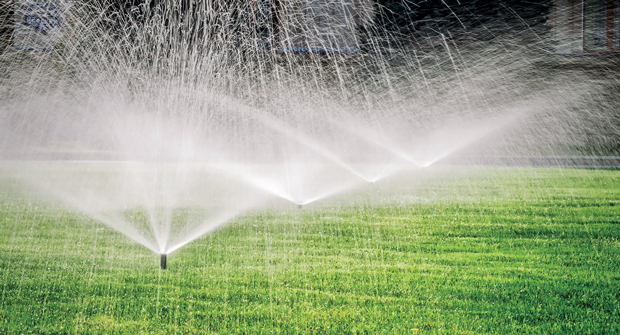As drip irrigation technology evolves, pros embrace the benefits beyond saving water.

In April, California’s governor officially declared the state’s nearly five-year-long drought to be over. While that news might be considered bad news for water conservation efforts, Rick Foster, principal product manager for drip irrigation for Rain Bird in Azusa, Calif., isn’t worried.
“Even in places where it starts to rain again, our industry continues to value drip irrigation not only because of water conservation but because of its other benefits too,” says Foster. “Water scarcity stimulated a need and introduced drip to people who hadn’t considered it before, but once they get a taste of it, they see more of its advantages.”
Drip irrigation technology continues to evolve as contractors embrace the benefits that drip systems can provide. Many manufacturers have introduced drip emitters with built-in check valves to prevent water from draining out of the lower emitters after the system valve closes. This feature is currently available in both drip line and individual point source drip emitters. Manufacturers and distributors are also producing new one-piece pressure-regulating filters, retrofit connection kits and adapters, and a greater variety of drip irrigation zone control kits and flow sensors.
On the controller side, the industry is seeing an increase in Wi-Fi- and Bluetooth-capable systems that work in conjunction with smartphones and the internet.
Stuart Spaulding, training and communications manager for Dig Corp. in Vista, Calif., says most advancements in drip irrigation products aim to increase irrigation efficiency, resulting in less water waste. Other benefits include lower system installation costs. He adds that the factors driving these new product trends include the rising cost of water and global competition, as well as increasing consumer education and awareness, consumer demand and governmental regulations.
“Manufacturers are always trying to make products that are more convenient to use and install, which saves consumers and contractors both time and money,” Spaulding says. “The smart contractors are adapting and educating their employees and clients about the benefits of these new technologies and products.”
But it’s not just about water conservation when it comes to drip irrigation. Foster says contractors are discovering drip’s additional uses and benefits as more of them become familiar with the technology.
“I would say five years ago those of us in drip were really focused on water conservation, but that’s old news now, it’s obvious,” says Foster. “The good news is there are other benefits that end users and contractors have learned about that continue to drive growth in drip irrigation.”
For example, Foster says contractors are beginning to realize that drip and subsurface drip irrigation can maximize water efficiency in windy environments. In particular, he has seen an increase in the use of drip irrigation on the green spaces of car dealerships to prevent overspray on their inventory. Public agencies, many of which were introduced to drip irrigation because of water scarcity issues, now use drip to decrease the likelihood of vandalism and to prevent damage from high levels of foot traffic. Sports fields are seeing the benefits of drip and subsurface drip irrigation, which provides water at such a slow rate the systems can run even while the fields are in use. This flexibility also helps control the firmness of the playing fields and eliminates slippery, unsafe surfaces.
“These uses have nothing to do with water conservation,” Foster says. “We are seeing customers leveraging drip because of its other benefits. It’s a very exciting time.”
Still a small share
Steve Hamburg, senior irrigation technician at Twin Oaks Landscape in Ann Arbor, Mich., says the company began installing irrigation systems about 10 years ago. While he says advancements in drip technology allow for intricate system designs that provide greater control with less water waste, less than 1 percent of the systems he installs are drip lines. Only about 2 percent of the company’s irrigation maintenance clients use drip lines for part of their systems. Twin Oaks provides 60 percent maintenance and 40 percent design/build services to a half residential, half commercial clientele.

“We have tried to embrace the new technology, but it’s really a product that is specific to a particular environment and to a particular client,” Hamburg says, noting the company is more focused on introducing their clients to Wi-Fi controllers. “We provide the information, but generally, our clients lean toward standard systems.”
Allan Wittur, owner of Aqua Irrigation in Brentwood Bay, British Columbia, says his company has been installing drip irrigation systems for about 10 years. While he agrees drip systems are much more efficient than their traditional counterparts, he says it can be challenging to educate customers on these benefits.
“People equate beautiful sprays with a well-run irrigation system,” Wittur says. “But that is not the only version of quality irrigation. Our clients are asking about drip, and some municipalities are insisting on it.”
Wittur says drip irrigation systems are a solution to water shortages that are taking place throughout North America, and are also ideal for mature garden spaces or for landscapes with plants that will grow quickly and block sprays. He notes the biggest challenge to installing drip systems is educating his crews about the importance of the aesthetics of the drip line.
“Customers don’t want to see the line,” he says. “We have to spend a little bit more time not only with the installation process to address this but in educating our install crews about the aesthetic issue.”
Industry experts agree that it’s important for contractors to be properly educated on new advancements to see their benefits.
Spaulding says most drawbacks to new technology occur because of a lack of product knowledge and improper installation procedures.
“It’s now more important than ever to choose the right product for each and every installation site,” he says. “Contractors should not hesitate to receive and accept various forms of product support and training if necessary.”
Foster says the Rain Bird Academy Irrigation Training Classes provide professional training and certification courses to help keep contractors in the know. The Irrigation Association, distributors and other manufacturers also provide drip-specific training.
“There are some contractors who have built their businesses on drip only,” Foster says. “Doing it well and creating a reputation for doing it well will only enhance their profitability over time.”


